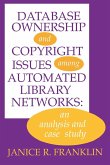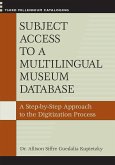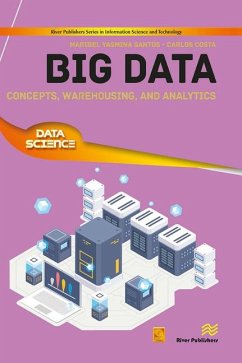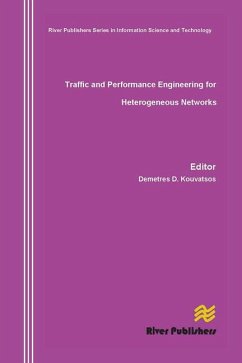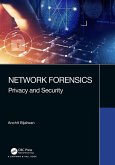Avita Katal, Hitesh Kumar Sharma, Jagdish Chandra Patni, Ravi Tomar
Database Management System
An Evolutionary Approach
Avita Katal, Hitesh Kumar Sharma, Jagdish Chandra Patni, Ravi Tomar
Database Management System
An Evolutionary Approach
- Broschiertes Buch
- Merkliste
- Auf die Merkliste
- Bewerten Bewerten
- Teilen
- Produkt teilen
- Produkterinnerung
- Produkterinnerung
This book explains the basic and advance concepts necessary for designing and implementing database systems and database applications. It puts emphasis on the core technical part of database modelling and design. It is meant to be used as a textbook for a technical course in database systems at the undergraduate and graduate level.
Andere Kunden interessierten sich auch für
![Database Ownership and Copyright Issues Among Automated Library Networks Database Ownership and Copyright Issues Among Automated Library Networks]() Janice R. FranklinDatabase Ownership and Copyright Issues Among Automated Library Networks62,99 €
Janice R. FranklinDatabase Ownership and Copyright Issues Among Automated Library Networks62,99 €![Subject Access to a Multilingual Museum Database Subject Access to a Multilingual Museum Database]() Allison KupietzkySubject Access to a Multilingual Museum Database54,99 €
Allison KupietzkySubject Access to a Multilingual Museum Database54,99 €![Big Data Big Data]() Maribel Yasmina SantosBig Data65,99 €
Maribel Yasmina SantosBig Data65,99 €![Traffic and Performance Engineering for Heterogeneous Networks Traffic and Performance Engineering for Heterogeneous Networks]() Traffic and Performance Engineering for Heterogeneous Networks67,99 €
Traffic and Performance Engineering for Heterogeneous Networks67,99 €![Network Forensics Network Forensics]() Anchit BijalwanNetwork Forensics72,99 €
Anchit BijalwanNetwork Forensics72,99 €![Science and the Internet Science and the Internet]() Science and the Internet92,99 €
Science and the Internet92,99 €![Cybersecurity Lessons from CoVID-19 Cybersecurity Lessons from CoVID-19]() Robert SladeCybersecurity Lessons from CoVID-1930,99 €
Robert SladeCybersecurity Lessons from CoVID-1930,99 €-
-
-
This book explains the basic and advance concepts necessary for designing and implementing database systems and database applications. It puts emphasis on the core technical part of database modelling and design. It is meant to be used as a textbook for a technical course in database systems at the undergraduate and graduate level.
Hinweis: Dieser Artikel kann nur an eine deutsche Lieferadresse ausgeliefert werden.
Hinweis: Dieser Artikel kann nur an eine deutsche Lieferadresse ausgeliefert werden.
Produktdetails
- Produktdetails
- Verlag: Taylor & Francis Ltd
- Seitenzahl: 229
- Erscheinungstermin: 13. März 2025
- Englisch
- Abmessung: 234mm x 156mm
- Gewicht: 470g
- ISBN-13: 9781032183466
- ISBN-10: 1032183462
- Artikelnr.: 73143554
- Herstellerkennzeichnung
- Libri GmbH
- Europaallee 1
- 36244 Bad Hersfeld
- gpsr@libri.de
- Verlag: Taylor & Francis Ltd
- Seitenzahl: 229
- Erscheinungstermin: 13. März 2025
- Englisch
- Abmessung: 234mm x 156mm
- Gewicht: 470g
- ISBN-13: 9781032183466
- ISBN-10: 1032183462
- Artikelnr.: 73143554
- Herstellerkennzeichnung
- Libri GmbH
- Europaallee 1
- 36244 Bad Hersfeld
- gpsr@libri.de
Jagdish Chandra Patni, Hitesh Kumar Sharma, Ravi Tomar, Avita Katal
1. Basics of Database. 1.1 Introduction and History of Database. 1.2 Data
and Information. 1.3 Database. 1.4 Need for a Database. 1.5 File based
database management system. 1.6 Database System. 1.7 Database System
components. 1.8 Database Management System Services. 1.9 Database
Characteristics. 1.10 Advantages of Database. 1.11 Limitations of Database.
Case Studies. Summary. Review Questions. References. 2. Data models and
Architecture of DBMS. 2.1 Evolution of Data Model. 2.2 Hierarchical
Database Model. 2.3 Network Data Model. 2.4 Relational Database Model. 2.5
Object Oriented Data Model. 2.6 Object Relational Data Model. 2.7 Three
Level Architecture of Database. 2.8 Data Independence. 2.9 Database
Languages. Summary. Review Questions. References. 3. Relational Database
Management System (RDBMS). 3.1 Difference Between RDBMS and DBMS. 3.2
Features of RDBMS. 3.3 Advantages of RDBMS. 3.4 Disadvantages of RDBMS. 3.5
Examples of RDBMS. 3.6 RDBMS Terminologies. 3.7 Keys in Database. 3.8
Integrity Constraints in DBMS. 3.9 Relational Algebra. 3.10 Structured
Query Language (SQL). 3.11 CODD's Twelve Rules of Relational Database. 3.12
Database Development Life Cycle. Summary. Case Studies. Review Questions.
References. 4. Entity Relationship Model. 4.1 Entity Relationship Diagram.
4.2 Components of a ER Diagram. 4.3 Participation Constraints. 4.4 Strong
and Weak Relationship. 4.5 Handling Many to Many Relationship. 4.6 Example
of E-R Model. 4.7 Enhanced Entity-Relationship Model. 4.8 Reduction of ER
Diagram to Relational model. Summary. Review Questions. References. 5.
Normalization. 5.1 Introduction Normalization -A bottom up approach. 5.2
Need for Normalization. 5.3 Types of Dependencies. 5.4 First Normal Form.
5.5 Second Normal Form. 5.6 Third Normal Form. 5.7 Boyce-Codd Normal Form.
5.8 Multi-valued Dependency. 5.9 Join Dependency. 5.10 Lossless and Lossy
Decompositions. Summary. Review Questions. References. 6. Managing Data
Using Structured Query Language (SQL). 6.1 Introduction to SQL. 6.2 Data
Definition Commands. 6.3 Data Manipulation Language (DML). 6.4 Data Control
Language. 6.5 Transaction Control Language (TCL). 6.6 Data Query Language
(DQL). 6.7 Aggregate Functions. 6.8 Date and Time Functions. 6.9 String
Functions. 6.10 Conversion Functions. 6.11 Mathematical Functions. 6.12
Special Operators. 6.13 Types of Constraints. 6.14 Sub Query. Summary.
Review Question. References. 7. Introduction to PL/SQL. 7.1 Variable and
Constants. 7.2 Data Types. 7.3 PL/SQL Literals. 7.4 Control Statement. 7.5
PL/SQL case statement. 7.6 PL/SQL Loop. 7.7 PL/SQL Continue statement. 7.8
PL/SQL GOTO statement. 7.9 PL/SQL Procedure and Functions. 7.10 PL/SQL
cursor. 7.11 PL/SQL Exception. 7.12 PL/SQL Exception Handling. 7.13 PL/SQL
Triggers. Summary. Review Questions. References. 8. Transaction Management
in Database. 8.1 Definition of Transaction. 8.2 Properties of Transaction.
8.3 States of Transactions. 8.4 Schedule. 8.5 Serializability. 8.6
Recoverable Schedules. 8.7 Concurrency Control. 8.8 Concurrency Control
Mechanism. 8.9 Database Back UP and Recovery. 8.10 Security, Integration
and Authorization. Summary. Review Questions. References.
and Information. 1.3 Database. 1.4 Need for a Database. 1.5 File based
database management system. 1.6 Database System. 1.7 Database System
components. 1.8 Database Management System Services. 1.9 Database
Characteristics. 1.10 Advantages of Database. 1.11 Limitations of Database.
Case Studies. Summary. Review Questions. References. 2. Data models and
Architecture of DBMS. 2.1 Evolution of Data Model. 2.2 Hierarchical
Database Model. 2.3 Network Data Model. 2.4 Relational Database Model. 2.5
Object Oriented Data Model. 2.6 Object Relational Data Model. 2.7 Three
Level Architecture of Database. 2.8 Data Independence. 2.9 Database
Languages. Summary. Review Questions. References. 3. Relational Database
Management System (RDBMS). 3.1 Difference Between RDBMS and DBMS. 3.2
Features of RDBMS. 3.3 Advantages of RDBMS. 3.4 Disadvantages of RDBMS. 3.5
Examples of RDBMS. 3.6 RDBMS Terminologies. 3.7 Keys in Database. 3.8
Integrity Constraints in DBMS. 3.9 Relational Algebra. 3.10 Structured
Query Language (SQL). 3.11 CODD's Twelve Rules of Relational Database. 3.12
Database Development Life Cycle. Summary. Case Studies. Review Questions.
References. 4. Entity Relationship Model. 4.1 Entity Relationship Diagram.
4.2 Components of a ER Diagram. 4.3 Participation Constraints. 4.4 Strong
and Weak Relationship. 4.5 Handling Many to Many Relationship. 4.6 Example
of E-R Model. 4.7 Enhanced Entity-Relationship Model. 4.8 Reduction of ER
Diagram to Relational model. Summary. Review Questions. References. 5.
Normalization. 5.1 Introduction Normalization -A bottom up approach. 5.2
Need for Normalization. 5.3 Types of Dependencies. 5.4 First Normal Form.
5.5 Second Normal Form. 5.6 Third Normal Form. 5.7 Boyce-Codd Normal Form.
5.8 Multi-valued Dependency. 5.9 Join Dependency. 5.10 Lossless and Lossy
Decompositions. Summary. Review Questions. References. 6. Managing Data
Using Structured Query Language (SQL). 6.1 Introduction to SQL. 6.2 Data
Definition Commands. 6.3 Data Manipulation Language (DML). 6.4 Data Control
Language. 6.5 Transaction Control Language (TCL). 6.6 Data Query Language
(DQL). 6.7 Aggregate Functions. 6.8 Date and Time Functions. 6.9 String
Functions. 6.10 Conversion Functions. 6.11 Mathematical Functions. 6.12
Special Operators. 6.13 Types of Constraints. 6.14 Sub Query. Summary.
Review Question. References. 7. Introduction to PL/SQL. 7.1 Variable and
Constants. 7.2 Data Types. 7.3 PL/SQL Literals. 7.4 Control Statement. 7.5
PL/SQL case statement. 7.6 PL/SQL Loop. 7.7 PL/SQL Continue statement. 7.8
PL/SQL GOTO statement. 7.9 PL/SQL Procedure and Functions. 7.10 PL/SQL
cursor. 7.11 PL/SQL Exception. 7.12 PL/SQL Exception Handling. 7.13 PL/SQL
Triggers. Summary. Review Questions. References. 8. Transaction Management
in Database. 8.1 Definition of Transaction. 8.2 Properties of Transaction.
8.3 States of Transactions. 8.4 Schedule. 8.5 Serializability. 8.6
Recoverable Schedules. 8.7 Concurrency Control. 8.8 Concurrency Control
Mechanism. 8.9 Database Back UP and Recovery. 8.10 Security, Integration
and Authorization. Summary. Review Questions. References.
1. Basics of Database. 1.1 Introduction and History of Database. 1.2 Data
and Information. 1.3 Database. 1.4 Need for a Database. 1.5 File based
database management system. 1.6 Database System. 1.7 Database System
components. 1.8 Database Management System Services. 1.9 Database
Characteristics. 1.10 Advantages of Database. 1.11 Limitations of Database.
Case Studies. Summary. Review Questions. References. 2. Data models and
Architecture of DBMS. 2.1 Evolution of Data Model. 2.2 Hierarchical
Database Model. 2.3 Network Data Model. 2.4 Relational Database Model. 2.5
Object Oriented Data Model. 2.6 Object Relational Data Model. 2.7 Three
Level Architecture of Database. 2.8 Data Independence. 2.9 Database
Languages. Summary. Review Questions. References. 3. Relational Database
Management System (RDBMS). 3.1 Difference Between RDBMS and DBMS. 3.2
Features of RDBMS. 3.3 Advantages of RDBMS. 3.4 Disadvantages of RDBMS. 3.5
Examples of RDBMS. 3.6 RDBMS Terminologies. 3.7 Keys in Database. 3.8
Integrity Constraints in DBMS. 3.9 Relational Algebra. 3.10 Structured
Query Language (SQL). 3.11 CODD's Twelve Rules of Relational Database. 3.12
Database Development Life Cycle. Summary. Case Studies. Review Questions.
References. 4. Entity Relationship Model. 4.1 Entity Relationship Diagram.
4.2 Components of a ER Diagram. 4.3 Participation Constraints. 4.4 Strong
and Weak Relationship. 4.5 Handling Many to Many Relationship. 4.6 Example
of E-R Model. 4.7 Enhanced Entity-Relationship Model. 4.8 Reduction of ER
Diagram to Relational model. Summary. Review Questions. References. 5.
Normalization. 5.1 Introduction Normalization -A bottom up approach. 5.2
Need for Normalization. 5.3 Types of Dependencies. 5.4 First Normal Form.
5.5 Second Normal Form. 5.6 Third Normal Form. 5.7 Boyce-Codd Normal Form.
5.8 Multi-valued Dependency. 5.9 Join Dependency. 5.10 Lossless and Lossy
Decompositions. Summary. Review Questions. References. 6. Managing Data
Using Structured Query Language (SQL). 6.1 Introduction to SQL. 6.2 Data
Definition Commands. 6.3 Data Manipulation Language (DML). 6.4 Data Control
Language. 6.5 Transaction Control Language (TCL). 6.6 Data Query Language
(DQL). 6.7 Aggregate Functions. 6.8 Date and Time Functions. 6.9 String
Functions. 6.10 Conversion Functions. 6.11 Mathematical Functions. 6.12
Special Operators. 6.13 Types of Constraints. 6.14 Sub Query. Summary.
Review Question. References. 7. Introduction to PL/SQL. 7.1 Variable and
Constants. 7.2 Data Types. 7.3 PL/SQL Literals. 7.4 Control Statement. 7.5
PL/SQL case statement. 7.6 PL/SQL Loop. 7.7 PL/SQL Continue statement. 7.8
PL/SQL GOTO statement. 7.9 PL/SQL Procedure and Functions. 7.10 PL/SQL
cursor. 7.11 PL/SQL Exception. 7.12 PL/SQL Exception Handling. 7.13 PL/SQL
Triggers. Summary. Review Questions. References. 8. Transaction Management
in Database. 8.1 Definition of Transaction. 8.2 Properties of Transaction.
8.3 States of Transactions. 8.4 Schedule. 8.5 Serializability. 8.6
Recoverable Schedules. 8.7 Concurrency Control. 8.8 Concurrency Control
Mechanism. 8.9 Database Back UP and Recovery. 8.10 Security, Integration
and Authorization. Summary. Review Questions. References.
and Information. 1.3 Database. 1.4 Need for a Database. 1.5 File based
database management system. 1.6 Database System. 1.7 Database System
components. 1.8 Database Management System Services. 1.9 Database
Characteristics. 1.10 Advantages of Database. 1.11 Limitations of Database.
Case Studies. Summary. Review Questions. References. 2. Data models and
Architecture of DBMS. 2.1 Evolution of Data Model. 2.2 Hierarchical
Database Model. 2.3 Network Data Model. 2.4 Relational Database Model. 2.5
Object Oriented Data Model. 2.6 Object Relational Data Model. 2.7 Three
Level Architecture of Database. 2.8 Data Independence. 2.9 Database
Languages. Summary. Review Questions. References. 3. Relational Database
Management System (RDBMS). 3.1 Difference Between RDBMS and DBMS. 3.2
Features of RDBMS. 3.3 Advantages of RDBMS. 3.4 Disadvantages of RDBMS. 3.5
Examples of RDBMS. 3.6 RDBMS Terminologies. 3.7 Keys in Database. 3.8
Integrity Constraints in DBMS. 3.9 Relational Algebra. 3.10 Structured
Query Language (SQL). 3.11 CODD's Twelve Rules of Relational Database. 3.12
Database Development Life Cycle. Summary. Case Studies. Review Questions.
References. 4. Entity Relationship Model. 4.1 Entity Relationship Diagram.
4.2 Components of a ER Diagram. 4.3 Participation Constraints. 4.4 Strong
and Weak Relationship. 4.5 Handling Many to Many Relationship. 4.6 Example
of E-R Model. 4.7 Enhanced Entity-Relationship Model. 4.8 Reduction of ER
Diagram to Relational model. Summary. Review Questions. References. 5.
Normalization. 5.1 Introduction Normalization -A bottom up approach. 5.2
Need for Normalization. 5.3 Types of Dependencies. 5.4 First Normal Form.
5.5 Second Normal Form. 5.6 Third Normal Form. 5.7 Boyce-Codd Normal Form.
5.8 Multi-valued Dependency. 5.9 Join Dependency. 5.10 Lossless and Lossy
Decompositions. Summary. Review Questions. References. 6. Managing Data
Using Structured Query Language (SQL). 6.1 Introduction to SQL. 6.2 Data
Definition Commands. 6.3 Data Manipulation Language (DML). 6.4 Data Control
Language. 6.5 Transaction Control Language (TCL). 6.6 Data Query Language
(DQL). 6.7 Aggregate Functions. 6.8 Date and Time Functions. 6.9 String
Functions. 6.10 Conversion Functions. 6.11 Mathematical Functions. 6.12
Special Operators. 6.13 Types of Constraints. 6.14 Sub Query. Summary.
Review Question. References. 7. Introduction to PL/SQL. 7.1 Variable and
Constants. 7.2 Data Types. 7.3 PL/SQL Literals. 7.4 Control Statement. 7.5
PL/SQL case statement. 7.6 PL/SQL Loop. 7.7 PL/SQL Continue statement. 7.8
PL/SQL GOTO statement. 7.9 PL/SQL Procedure and Functions. 7.10 PL/SQL
cursor. 7.11 PL/SQL Exception. 7.12 PL/SQL Exception Handling. 7.13 PL/SQL
Triggers. Summary. Review Questions. References. 8. Transaction Management
in Database. 8.1 Definition of Transaction. 8.2 Properties of Transaction.
8.3 States of Transactions. 8.4 Schedule. 8.5 Serializability. 8.6
Recoverable Schedules. 8.7 Concurrency Control. 8.8 Concurrency Control
Mechanism. 8.9 Database Back UP and Recovery. 8.10 Security, Integration
and Authorization. Summary. Review Questions. References.


